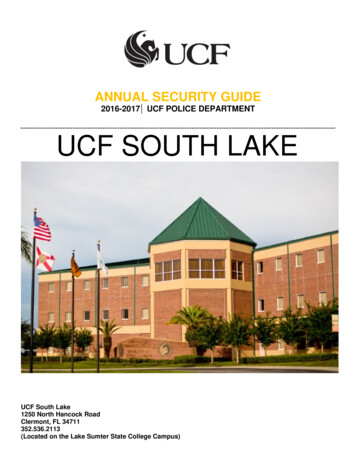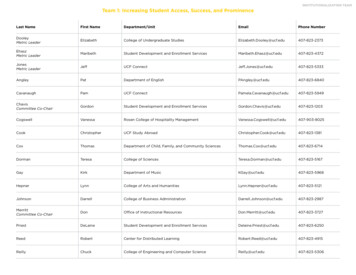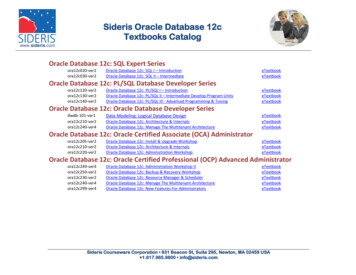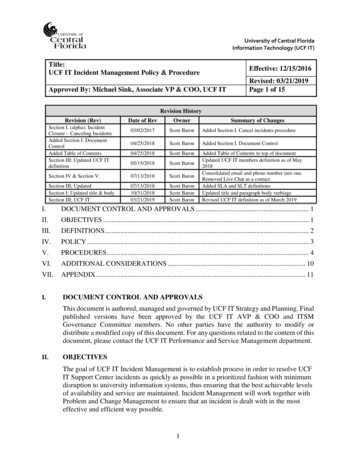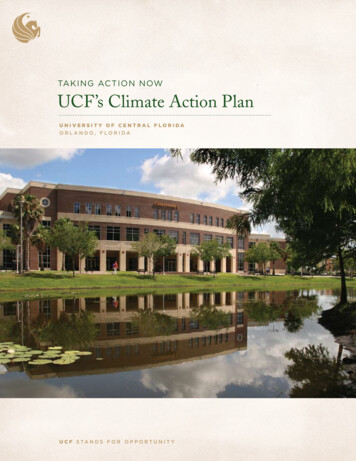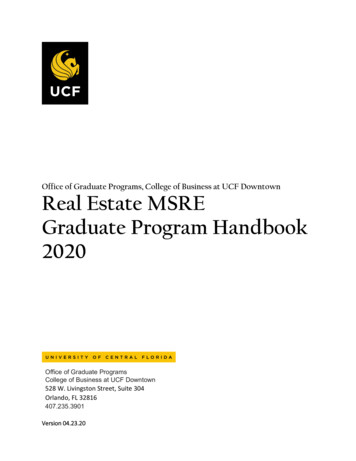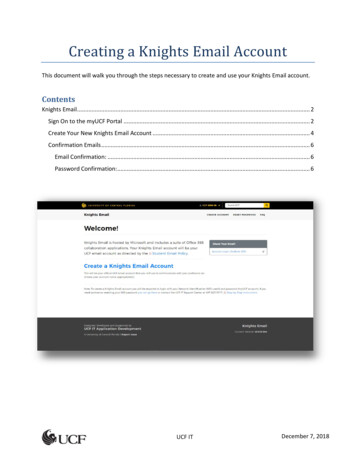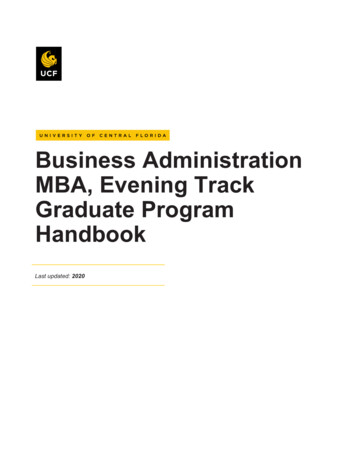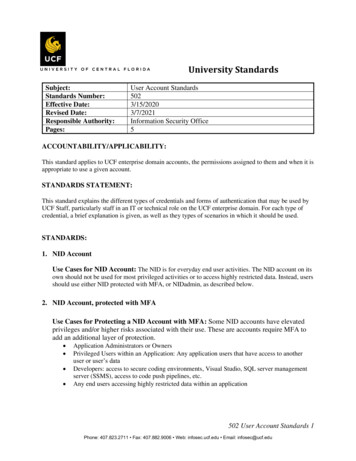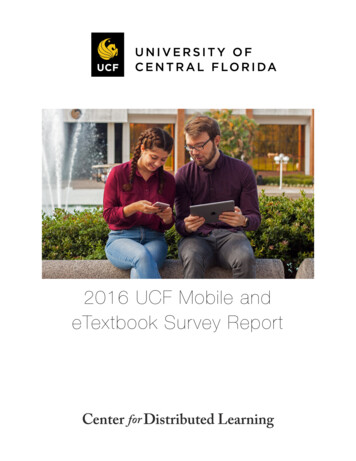
Transcription
2016 UCF Mobile andeTextbook Survey Report
Table of ContentsExecutive Summary1Mobile Device Ownership and Usage2General Ownership2General Usage34Mobile App Usage and BeliefsStudent Use of Mobile Apps4Instructor Support5Beliefs56eTextbook Usage and BeliefsUsage6Instructor Use8Beliefs810Recommendations1. Review and improve infrastructure on campus.102. Integrate campus life and academic activities within university apps.103. Create faculty development opportunities.114. Support information fluency among young, undergraduate students.115. Select providers that are eTextbook friendly.1213About This ReportReferences13Institutional Review Board13Contact Information13Acknowledgements13
Executive SummaryThe 2016 EDUCAUSE Technology Research in theAcademic Community (Dahlstrom, Brooks, Pomerantz, &Reeves, 2016) reported that mobile technologies arepervasive in the lives of students, with 90% owning asmartphone and 60% owning a tablet. The majority ofstudents use their devices in most or all of their coursesand feel their device is very or extremely important to theiracademic success.To appreciate the landscape of this mainstream technologyon campus, a comparative study on adoption of mobilelearning and eTextbooks at the University of Central Florida(UCF) is being conducted.In 2012, UCF’s Center for Distributed Learning (CDL) distributed the first survey to students. The 2012 survey report canbe downloaded at: http://mobile.cdl.ucf.edu/?p 60. A follow-up survey was distributed in Spring 2014. The 2014 surveyreport can be downloaded at: http://mobile.cdl.ucf.edu/?p 672.This report will share the results from the most recent survey that was conducted in Spring 2016. The survey includesboth closed and open-ended questions which are based on existing research and surveys previously distributed by theuniversity. It was structured in two main categories: mobile learning (devices and apps) and eTextbooks. Topics includedevice ownership, access, and beliefs towards the technologies concerning areas such as learning, sense of community,and engagement. Student responses to this survey will allow us to gauge a baseline for usage and beliefs at UCF,compare the results with the 2012 and 2014 surveys, and shape the next course of action.Key findings of this report include: Ownership of mobile devices is high and continues to increase among students. Student status, sex, and age (18-64) were demographic factors relating to ownership of mobile devices. There is still a large difference between instructors requiring the use of mobile devices in coursework and studentsreporting the use of mobile devices on their own for learning. Student classification, residence, race, sex, and GPA were demographic factors relating to student-reported useof mobile devices, tablets, and e-Book readers for learning purposes. 65% of students (n 951) indicated that they had used a mobile app for learning at least once each week. Students reported modest instructor support for using mobile apps/devices in coursework. Limited internet connectivity is the top reason students may not want instructors to use mobile apps/devices. 66% of students (n 974) reported using an eTextbook at least once in their college studies. Student status, age, and discipline emerged as significant factors for predicting eTextbook usage. Instructors are modestly integrating eTextbooks within courses, with room for improvement. Student preference for print textbooks is not a significant deterrent to eTextbook use. Most students have mixed beliefs about technical skills, study skills, learning effectiveness, engagement, andsense of community with relation to using eTextbooks.This report is structured in three sections: mobile device general ownership and usage; mobile app usage and beliefs;and eTextbook usage and beliefs. Recommendations for future action are proposed in the conclusion.2016 UCF Mobile and eTextbook Survey Report"1
Mobile Device Ownership and UsageGeneral Ownership Ownership of smartphones is high at 99% (Figure 1). Most students own at least one iPhone (69%) or Androidsmartphone (27%) (Figure 2). Ownership of tablets is relatively low when compared to smartphones. Tablet ownership is at 63% (Figure 1). Moststudents own at least one iPad (36%) or Android tablet (10%) (Figure 3). e-Book reader ownership is 35% (Figure 1). Most students own at least one Kindle (21%) or Nook (8%) (Figure 4). Wearable ownership is low at 28% (Figure 1), with the majority of students owning a Fitbit (12%) (Figure 5).99%63%35%SmartphoneTablet28%e-Book ReaderWearableFigure 1: Device Ownership (N 1,474)69%3% own multiple smartphones7% own multiple tablets36%23%27%5%2%iPhoneAndroidOtherFigure 2: Smartphone Ownership (N 1,474)21%3% own multiple e-Book readersiPadAndroidMS SurfaceFigure 3: Tablet Ownership (N 1,474)12%7%8%4%3%KindleNookOtherFigure 4: e-Book Reader Ownership (N 1,474)2016 UCF Mobile and eTextbook Survey ReportFitbitApple WatchOtherFigure 5: Wearable Ownership (N 1,474)"2
Student status, sex, and age (18-64) were demographic factors relating to ownership of mobile devices. Younger students reported owning more smartphones than older students. Graduate students reported owning more tablets and e-Book readers than undergraduate students. Female students reported owning more tablets and e-Book readers than male students. Part-time students reported owning more tablets and e-Book readers than full-time students. Older students reported owning more tablets and e-Book readers than younger students.General UsageThere is a large difference between instructors requiring the use of mobile devices in coursework and students reportingthe use of mobile devices on their own for learning (Figure 6). 26% of students reported that their instructors asked them to use a smartphone (e.g., iPhone, Android Phone) tocomplete an assignment.82% of students reported using smartphones on their own for learning. 14% of students reported that their instructors asked them to use a tablet (e.g., iPad, Kindle Fire, Android Tablet)to complete an assignment.37% of students reported using tablets on their own for learning. 8% of students reported that their instructors asked them to use an e-Book reader (e.g., Kindle, Nook, SonyReader) to complete an assignment.16% of students reported using e-Book readers on their own for learning. By comparison, 82% of students reported that their instructors asked them to use a laptop/desktop to completean assignment, while 92% of students reported using laptop or desktop on their own for -Book ReaderFigure 6: Student Usage to Instructor Requirement of Devices for Assignments (N 1,474)2016 UCF Mobile and eTextbook Survey Report"3
Student classification, residence, race, sex, and GPA emerged as demographic factors relating to student-reported useof mobile devices, tablets, and e-Book readers for learning purposes. Male students reported using smartphones for learning more than female students. Part-time students reported using tablets for learning more than full-time students. Students living on campus reported using tablets for learning more than students off campus. Multiracial, Asian, and white students reported using tablets for learning more than other students. Students with higher GPAs reported using e-Book readers for learning more than students with lower GPAs.Mobile App Usage and BeliefsStudent Use of Mobile Apps65% of students (n 951) indicated that they had used a mobile app for learning at least once each week. The use ofapps in students’ personal lives is extensive and varied. Students selected the app categories that they used mostfrequently (Figure 7).Music77%Social Networking76%Social Media69%Entertainment67%Navigation57%UCF vity0%20%40%60%80%100%Figure 7: Most Popular App Categories for Student Personal Use (N 1,474)2016 UCF Mobile and eTextbook Survey Report"4
When asked how often students use UCF mobile apps for learning: 78% responded that they use Canvas Mobile for learning. 70% responded that they use UCFMobile (http://ucfmobile.ucf.edu) for learning.When asked how students would like UCF to use mobile apps/devices in the future, these areas were most identified: Parking Availability - 78% Maps (GPS Directions) - 55% Coursework - 54% Computer Availability - 51% Knights Cash - 48% Regional Campus Maps - 41%Instructor Support35% of students (n 469) indicated they would like their instructors to use more mobile apps or devices in coursework.However, students reported modest support from instructors who are using mobile apps/devices in coursework. 39% of students reported their instructor provided instruction on how to use the mobile app/devices incoursework. 29% reported their instructor modeled the use of mobile apps/devices in class. 36% reported their instructor clearly stated the requirement of using a mobile apps/devices in coursework in thecourse syllabus.In a follow-up question, the top reasons given for not wanting instructors to use apps/devices include: Limited internet connectivity (on and off campus): 41% Limited funds: 34% Lack of technical support: 29% No interest in learning with a mobile device: 27% Limited or no access to mobile devices: 23% Limited or no access to training resources: 20%BeliefsUsing a 5-point Likert scale from “strongly agree” to “stronglydisagree,” students were asked about the use of mobile apps/devices for academic purposes. Students (N 1,474) agreed orstrongly agreed to the following items: Easier to access coursework: 74% Increases communication with other students: 66% Increases communication with instructor: 65% Increases knowledge in field of study: 52% Improves quality of work: 47% Increases motivation to complete coursework: 45%2016 UCF Mobile and eTextbook Survey Report"5
eTextbook Usage and BeliefsUsage66% of students (n 974) reported using an eTextbook at least once in their college studies (Figure 8). Among thesestudents, multiple types of eTextbooks were used. 51% had used an eTextbook which had basic features like highlighting and annotations. 37% had used an eTextbook which was a PDF (replica of the print version). 24% had used an eTextbook which contained interactive elements. 20% had used an open eTextbook (free and available online). 5% had used an eTextbook that was created by the instructor.Basic Features51%PDF37%Interactive Elements24%20%Open5%Instructor Created015304560Figure 8: Types of eTextbooks used at least once by students (n 974) 60% indicated they had purchased at least one eTextbook, while 59% indicated they had rented.31% obtained eTextbooks from the campus bookstore.75% obtained eTextbooks from an online retailer.35% obtained eTextbook that was bundled with a print book.10% obtained the book by sharing with a friend. 55% were required to use the eTextbook in their course by the instructor. 41% first became aware of the eTextbook option on their own, 42% from the instructor, while 8% heard about theoption from peers. Low cost (74%) and ability to access the textbooks anywhere (63%) were top factors to influence the students’decision to adopt an eTextbook.Student status, age, and discipline emerged as demographic factors that related to eTextbook usage. Undergraduate students reporting using eTextbooks more than graduate students. Younger students reporting using eTextbooks more than older students. eTextbooks were used significantly more in disciplines such as science, business, engineering, and health.2016 UCF Mobile and eTextbook Survey Report"6
Of all students (N 1,474), including those who have used or not used an eTextbook in their college studies: The top reason why they would not use an eTextbook was the preference for print textbooks (17%). Around 5% indicated that they were not familiar with eTextbook or were unaware of the eTextbook option.Students used computers most frequently to access eTextbooks rather than mobile devices, tablets, or e-Book readers(Figure 9). Among students who have used an eTextbook (n 974): 82% reported using a computer the most to access eTextbooks. 12% reported using a tablet the most to access eTextbooks. 3% reported using an e-Book reader the most to access eTextbooks. 1% reported using a smartphone device the most to access eTextbooks.Computer82%Tablet12%3%e-Book Reader1%Smartphone022.54567.590Figure 9: Devices most frequently used to access eTextbooks (n 974)Students who have used eTextbooks were not always actively using the features that facilitate reading and studying.Around 53% of students reported that they seldom or never actively used the features such as highlighting and makingnotes.2016 UCF Mobile and eTextbook Survey Report"7
Instructor UseAmong students who have used an eTextbook (n 974): 46% said the electronic nature of the textbook was stated inthe syllabus. 44% said the instructor provided instruction on how to usethe eTextbook. 34% said the instructor modeled the use of the eTextbook inclass. 48% said the instructors seldom or never actively used thefeatures of eTextbooks.Beliefs38% of students who have used eTextbooks (n 359) would like theirinstructors to use more eTextbooks in coursework, while 36%disagree, and 26% are unsure. Students indicated that reading,study, and instructor features were “important” or “very important” intheir decision to adopt an eTextbook. Features that were more socialin nature were not deemed as important (Figure 10). 80%: Reading features such as searching for keywords,glossary, zooming text, and multimedia 77%: Study features such as highlighting, tagging, making notes, taking quizzes 71%: Instructor features such as being able to read instructor notes and highlights 38%: Social features such as sharing a passage on Facebook, following users on Twitter, taking a class poll,leaving notes for others to ialFigure 10: Most important eTextbook features perceived by students (N 1,474)2016 UCF Mobile and eTextbook Survey Report"8
Most students believed they have the technical and study skills to adapt to an eTextbook but were mixed about learningeffectiveness, engagement, and sense of community. Among all surveyed students (N 1,474): 78% of students believed they have the technical skills to adapt to an eTextbook. 58% of students believed they have the study habits to adapt to an eTextbook. 47% of students believed eTextbooks are more suited in online classes (32% neutral). 44% of students believed that they can learn as effectively as with a print book (27% neutral). 30% of students found reading an eTextbook as easy as a print textbook (57% neutral). 23% of students believed that they would be more motivated to use an eTextbook (34% neutral). 20% of students believed that eTextbooks could strengthen the sense of community in the class (59% neutral). 18% of students believed that they would be more engaged by using an eTextbook (54% neutral).2016 UCF Mobile and eTextbook Survey Report"9
RecommendationsBased on the survey results, we propose the following recommendations:1. Review and improve infrastructure on campus.Of the students surveyed, 35% indicated that they would like their instructors to use more mobile apps or devices as partof their academic experience. That statistic reveals a significant percentage of students who did not answer. It is possiblethat they hold a negative perception about the use of mobile technology for academic purposes, or are ambivalent atbest. Upon further inquiry, students noted that limited internet connectivity, limited funds, lack of technical support, andlimited access to the technology are all reasons why they would not want their instructors to use mobile devices foracademic experiences. Therefore, our recommendations entail enhancing the infrastructure or knowledge of existinginfrastructure at the institution.We recommend that UCF should continue to: Improve the WiFi signal throughout campus. Due to previous upgrades in wireless infrastructure, it is possible thatthe access points exist, but bandwidth in certain locations may be an issue. This particular recommendation islikely to carry over into future studies. More students are access the wireless system with more devices perstudent. Therefore, the wireless infrastructure will need continuous improvement. Provide increased access to mobile devices and heighten awareness of current programs that allow students topurchase devices at a discounted price. Increase promotion of student technical support options. Currently, UCF provides options for student technicalsupport, but the survey results indicate that students may not be aware that support exists, especially for mobiledevices. Furthermore, instructors who use mobile apps and devices for academic experiences should alsoprovide insight to students as to where they can acquire support.2. Integrate campus life and academic activities within university apps.Student ownership of smartphones continues to remain high at 99% and the technology is ubiquitous on campus. Evenwith tremendous ownership, the use of mobile technologies with coursework still falls short of personal usage. In an effortto encourage more use of mobile devices, particularly smartphones, we recommend adding more value throughacademic support and mobile opportunities for students and faculty. Over the past two years, UCF has made an effort toadd more value through the redesign of the UCF Mobile app, the addition of UCF Apps (Citrix Receiver), and otherservices such as mobile tracking of shuttles, parking, and further development of myUCF Mobile.We recommend that UCF continue to invest in resources that will enhance the student and faculty experience at UCF. Personalized notifications. Push notifications have become common with most services and are frequentlyexpected and preferred for most college-age students. UCF currently uses email as the main and only source ofofficial feedback outside of UCF Alerts. Universities and colleges are exploring and implementing systems that willgive students and faculty personalized notifications regarding deadlines, financial aid updates, grade availabilityand much more. These are generally tied to specific information inside the university portal. This can lead to moreawareness, increased academic performance, and better tracking of academic status. Beacons. A large portion of the UCF population still visits a physical campus, particularly the main campus. Whilevisiting the campus, students can miss out on events, activities, and academic opportunities. The use of Beaconscan help bridge this gap by sending notifications to users when in a specific location. These location-awarenotifications can help bring more value to on-campus resources, increase engagement through events, andpromote discovery of important campus resources.2016 UCF Mobile and eTextbook Survey Report1" 0
Real-time availability of resources. The UCF library currently has real-time availability of computers, rooms, andresources in a web and mobile format. This service is convenient for users to locate the best place to meet, study,and engage in campus resources. This service should be extended to other on campus labs and any entity thathas a resource to offer, such as Classroom I, Tech Commons, and the Student Union.3. Create faculty development opportunities.With a marked difference in instructors requiring mobile/smartphone usage (28%), compared to the high number ofstudents reporting usage for learning (82%), there is a clear need to inform faculty on current trends in student usage topromote more mobile adoption. Alongside the current trends in student usage, there are also pedagogical reasons forimplementation and student learning experiences. 66% of students (n 974) reported using an eTextbook at least once intheir college experience. Students emphasized that they used features such as highlighting and annotations, interactiveelements, and ease of access to PDFs to assist in their learning experiences. Students are learning by using the benefitsof these eTextbooks with their devices.UCF is unique in many of its professional development offerings, especially those offered to faculty teaching in a blendedor online format. One distinctive element is the mandatory course IDL6543 that is required for faculty teaching online atUCF. An additional course, IDL7000, is offered to veteran online faculty. These offerings provide the instructionaldesigners at UCF a unique opportunity to inform faculty of online pedagogy and, just as important, campus resourcesand professional development opportunities focused on mobile and eTextbook resources. Featured below are currentaction items and future plans to support faculty and students at UCF with mobile and eTextbook implementationsuccess. A presentation has been added to IDL6543 about best practices in mobile design. Along with highlighted elements of mobile/eTextbooks best practices in both IDL6543 and IDL7000, moreadvanced and detailed professional development courses, Textbook Essentials and Mobile Essentials, have beencreated and are open for faculty use. These courses are modular and allow individuals to work through theexperience step-by-step, or pick and choose from the module-specific content that they would like to focus on. A university task force focused on Textbook Affordability will be established in 2017, with one of the tasks being toidentify instructors that are using open books, which are almost always digital in nature. These case stories will bedisseminated among faculty.4. Support information fluency among young, undergraduate students.Survey results indicate that younger, undergraduate students exhibit two significant trends. First, they are more likely toown smartphones than their older counterparts. Given that 82% of students reported using a smartphone on their ownfor learning at least once a week, it is likely that most are in this younger demographic. However, of the devicesmentioned in the survey, instructors are least likely to support instruction integrating smartphones. Second, youngerundergraduate students are more likely to use eTextbooks. The general trends in this area suggest that although use isincreasing and the preference for print is plummeting in this demographic, beliefs and active use of eTextbooks havedwindled. This suggests ambivalence about the technology; eTextbooks are being used because they are growing infamiliarity and convenience, but they are not seen as pedagogically advantageous. Both of these trends point to the need for information fluency among younger undergraduate students.Thistraining would need to be device and platform agnostic, and focused on students’ study skills. Digital reading,especially using smartphones, is different than reading a traditional print book. Students are often not givendevelopment in this area, nor are instructors.2016 UCF Mobile and eTextbook Survey Report1" 1
The library emerges as a potential venue for this type of support. Currently, the UCF Library has several moduleson Information Fluency. Results from this survey can help craft a new module.5. Select providers that are eTextbook friendly.Survey results indicated students obtained eTextbooks from a variety of sources including the campus bookstore, onlineretailers, or through a bundled print textbook. Most notably, 75% of respondents used an online retailer to acquire theeTextbook compared to 35% using the campus bookstore. It is imperative for the campus bookstore to offer competitivepricing and multiple lengths of time to access eTextbooks. The institution needs the flexibility to explore bulk purchasing or direct license agreements with eTextbookproviders. These methods would allow for the advantage of scale and a consistent reading experience forstudents. Currently, the bookstore contract prohibits such endeavors. 82% of students reported using a computer the most to access eTextbooks. This high percentage could be dueto the inadequacy to present eTextbooks on a mobile device. During the selection of course materials, facultyshould request an eTextbook evaluation copy to test on a mobile device. The faculty can provide students advicefor the optimum hardware and software configurations. Only 5% of students responded using an eTextbook created by the faculty member. Incentives and institutionalresources are required to assist faculty in the development of their own eTextbook for student use. Variousinstitutions, such as Boise State University, provide faculty development, stipends, and resources to aid in suchendeavors. In 2017, faculty at UCF will be offered a cash incentive to enhance at least one of their courses withopen educational resources (OERs). Faculty will learn strategies to find, reuse, remix, create, and share OERswithin copyright and fair use guidelines, with an emphasis on student engagement and active learning.2016 UCF Mobile and eTextbook Survey Report1" 2
About This ReportReferencesDahlstrom, E., Brooks, D. C., Pomerantz, J., & Reeves, J. (2016). 2016 students and technology research study.EDUCAUSE Center for Analysis and Research (ECAR). Retrieved from: al Review BoardOn 2/13/2014, the IRB approved the following activity as human participant research that is exempt from regulation:Project Title: Mobile Learning and E-Textbook SurveyPrimary Investigator: Baiyun ChenIRB Number: SBE-12-08441Contact InformationIf you are interested in learning more about this survey, or are interested in participating in research opportunities relatedto mobility and/or eTextbooks, please contact us at the following:UCF Center for Distributed Learning2701 Pegasus DriveOrlando FL 32816-2810Phone: (407) 823-4910Email: ucfmobile@ucf.eduCDL Mobile & eTextbook Survey Team:Website: http://mobile.cdl.ucf.eduDr. Baiyun Chen - baiyun.chen@ucf.eduRyan Seilhamer - ryan.seilhamer@ucf.eduDr. Aimee deNoyelles - aimee.denoyelles@ucf.eduJohn Raible - john.raibile@ucf.eduSue Bauer - sue.bauer@ucf.eduDr. Luke Bennett - luke.bennett@ucf.eduAcknowledgementsAll photos taken by Ryan Seilhamer. Special thanks to Ashley Torres and Steven Lykins.2016 UCF Mobile and eTextbook Survey Report1" 3
learning and eTextbooks at the University of Central Florida (UCF) is being conducted. In 2012, UCF's Center for Distributed Learning (CDL) distributed the first survey to students. The 2012 survey report can . 2016 UCF Mobile and eTextbook Survey Report "2 iPhone Android Other 2% 27% 69% Smartphone Tablet e-Book Reader Wearable 28% 35% 63 .
